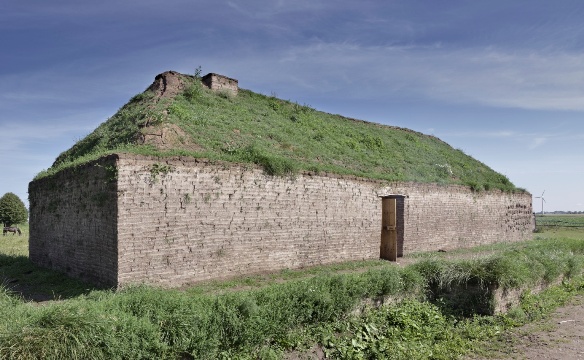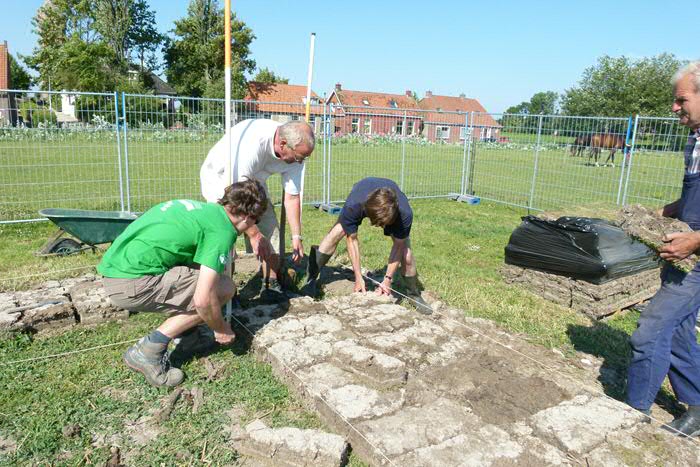Reconstruction of early Medieval sod house underway
In Firdgum (Friesland), reconstruction of the sod house that partially collapsed in November has started. The reconstruction project is headed by the Terpencentrum of the University of Groningen, in collaboration with inter alia the Province of Fryslân and the Yeb Hettinga Museum. The reconstruction work will be entirely performed by volunteers.
The archaeologists involved have been working on an improved design over the past few months, together with senior students of architecture from NHL University of Applied Sciences. The new sod house will not only be safe for visitors, but its execution will also better fit current knowledge of early Medieval farm construction. A team of enthusiastic volunteers started building the new sod walls and the wooden roof construction this week. The work will take at least three months. If you would like to become a volunteer, you can register for full or half-days by contacting Trijneke Sibma of the Terpencentrum.

Restoration or reconstruction
After the collapse in November 2013, caused by undetected water infiltration in the sod walls, measures were taken to prevent further damage to what was left of the building. It quickly became clear that the organizations involved were keen to see the building restored and that there were also sufficient technical and financial resources. A few weeks before the work started, however, it turned out that the surviving stable section required too many adjustments to reuse it in its current form. It was therefore decided to demolish this part also and to rebuild the sod house in its entirety, in phases. The first two steps will cover rebuilding the sod walls and the wooden roof construction. The next steps will be the roofing material and the furnishing of the building. It is not yet certain when these last two steps can be implemented.

Building with sods in the early Middle Ages
In the period before the construction of the dykes, the North Netherlands landscape was still openly connected with the sea, and the region flooded regularly. Nevertheless, these tidal marshes were an attractive habitat for humans; they built their farms on artifical mounds, known as terpen and wierden. Partly because no trees could grow in this open coastal landscape, the roof-bearing walls were completely constructed from grass sods laid one on top of the other. The archaeological reconstruction in Firdgum should clarify exactly how this was possible. The project, an archaeological experiment, forms part of the PhD research on early Medieval building traditions being conducted by Daniël Postma at the University of Groningen. The building forms part of the archaeological support centre in Firdgum and will be reopened to the public on completion of the project.
Volunteers
The building work is being done entirely by volunteers. Most of them come from around Firdgum and were also involved in the building of the first sod house. The knowledge and experience they gained then will stand them in good stead now. The project provides a unique opportunity for those interested to learn more about the building traditions of the early terp dwellers and experience themselves how the ancient Frisians built their farmhouses. The organization hopes that more young people from the region will want to help with the building in the last weeks of their summer holidays. The working days in the next few weeks will be Tuesdays to Saturdays. Volunteers are urgently needed for the afternoons in particular.
Special thanks to
The Sod House Project is coordinated by the Terpencentrum and financially supported by the Province of Fryslân and the University of Groningen. The project is being implemented in collaboration with the Yeb Hettinga Museum, NHL University of Applied Sciences and It Fryske Gea.
More information
Contact person/project leader University of Groningen: Daniël Postma
You can follow the progress of the building work via Twitter (@zodenhuis) and on the public Facebook page (www.facebook.com/zodenhuis).
| Last modified: | 19 March 2020 12.21 p.m. |
More news
-
23 April 2024
Studying depopulation also means studying the history of those who stay
Assistant professor Yuliya Hilevych from the Faculty of Arts researches regional depopulation in the Netherlands, Finland, and Ukraine by placing the phenomenon in a social-historical perspective.
-
22 April 2024
Trump or no trump, that is the question
UG researchers Ritumbra Manuvie, Pieter de Wilde, and Lisa Gaufman look ahead to the elections in India, Europe, and the United States, respectively. This week: Lisa Gaufman.
-
15 April 2024
‘The European elections will be as boring as always’
UG researchers Ritumbra Manuvie, Pieter de Wilde, and Lisa Gaufman look ahead to the elections in India, Europe, and the United States, respectively. This week: Pieter de Wilde. He predicts that the European elections will be as boring as always.
